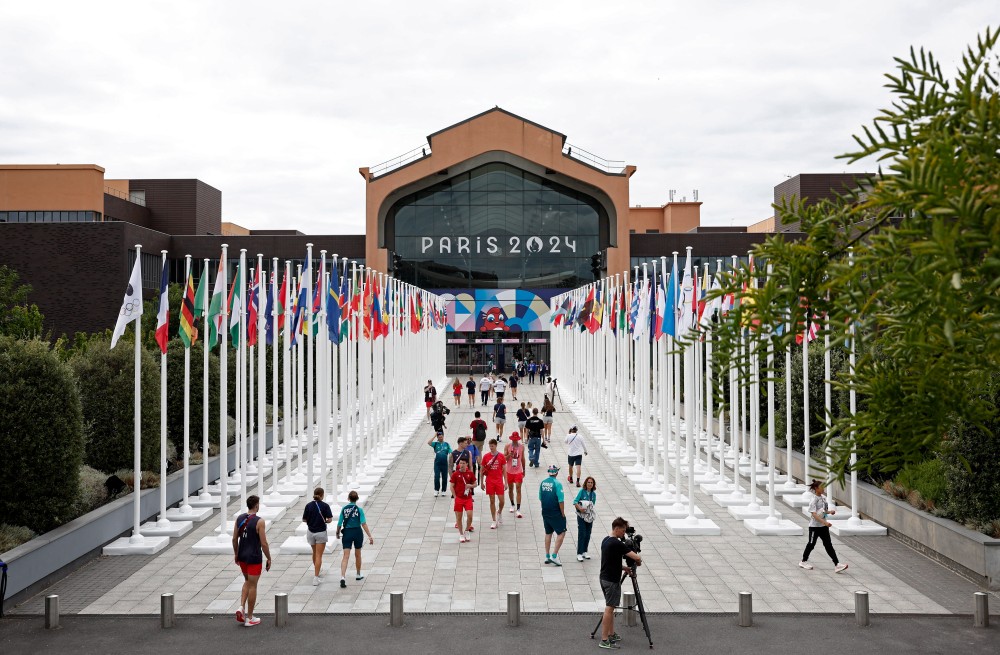
By Caroline de Sury
PARIS (OSV News) — If one were looking for the busiest woman in the church of France these days, Isabelle de Chatellus, 46, from the Diocese of Versailles, is most probably the one.
She is the director of the “Holy Games,” the French Catholic Church’s initiative for the Olympic Games, coordinating teams of volunteers recognizable by their yellow T-shirts with the Holy Games logo.
“I have just come out of the Olympic Village in Saint-Denis,” Chatellus told OSV News. “It is a pretty extraordinary place, particularly peaceful. It is a village where all humanity seems to come together. The flags of the countries represented are on every window! It is very beautiful.”
She said that in a multifaith center located on the outskirts of the village, “there were not a huge amount of people at first,” Chatellus said. “But little by little, the athletes are making the place their own, getting to know it better. They start to come and go, and little by little, they know when the prayer times are.”
To Catholics participating in the Olympic Games, Chatellus suggested the athletes “go to Mass at the nearby church. It is celebrated there for them every evening. They come there in privacy, to recharge their batteries, discreetly. It is very beautiful to see them reflected in this way.”
She commented on the opening ceremony of the Olympics July 26 that featured a drag-queen performance that parodied Leonardo da Vinci’s iconic painting of the Last Supper, creating division and drawing criticism from Catholic and other religions all over the world. Chatellis said that it “unsettled Christians the world over,” and that the Holy Games committee “received many messages from wounded people, deeply saddened by certain passages in the ceremony.”
However, she also mentioned they “had a lot of dialogue with International Olympic Committee members following this,” admitting that “it was a bit tricky.”
Chatellus explained that after the ceremony, “we really wanted to turn the page” and focus on welcoming the athletes and delegations.
Young people volunteering for the Holy Games in particular are experiencing the spiritual richness of the project.
“They are organized in small groups, and have morning times for resourcing and formation, to deepen the meaning of Christian virtues,” she said.
The highlight of the week for them is the veneration of the crown of thorns, which takes place on Fridays at the church of Saint Germain l’Auxerrois, close to the Louvre Museum.
The crown of thorns takes the form of a circle, 8.3 inches in diameter. It is the most precious of the relics in the Notre Dame Cathedral’s treasury. It was saved from the flames on the evening of the cathedral fire April 15, 2019, by the Parisian fire brigade’s chaplain, Father Jean-Marc Fournier, and waits in Saint Germain l’Auxerrois until it’s brought back to Notre Dame after the cathedral reopens Dec. 8.
“It is a great opportunity,” Chatellus pointed out. “Normally this veneration is only offered during the Fridays of Lent. It helps (one) meditate on the laurel wreath of the athletes, and to remind ourselves of the hope that Christ’s crown of thorns represents for Christians.”
The laurel wreath has been a symbol of victory, success and fame since the first Olympics in Greece.
Young people are particularly active at the La Madeleine church, or St. Mary Magdalene Church, located 500 feet from the Concorde Olympic site, where an interim stadium has been set up to host skateboarding, BMX Freestyle and 3×3 basketball.
“The Concorde metro station is closed, so everyone arrives via the Madeleine station,” Chatellus said. “Therefore, there are a lot of people around the church, and many of them enter.”
Inside the iconic church, where the Olympic truce was launched July 19 in the presence of over 100 diplomatic delegations, young volunteers invite visitors and the faithful to place intentions in the “sportsmen’s chapel” or to place a candle to pray for peace. Mass and confessions are offered in different languages. Every evening, a music festival takes place, alternating classical music, pop worship, gospel and Christian rock.
Another Holy Games venue that mobilizes the young people is located near another Parisian square, Place de la Nation. There, in the buildings of the Eugène Napoléon Foundation, young people welcome local children every other day for sports activities, and every other day some 50 people in need are served meals.
“This service dimension makes the young people very happy,” Chatellus said. “They testify that the atmosphere and their program reminds them of World Youth Day, with its gatherings and moments of prayer. But many say it is even better, because of this dimension of service.”
Meanwhile, the Holy Games web page continues to welcome pledges from those who sign up to support the athletes with their prayers. A special invitation is extended to pray for the 37 athletes of the Olympic Refugee Team. They are from 11 different countries.
For her part, Chatellus is enjoying the Olympic Games as a sportswoman. “I love sports,” she said. “I love all sports! I play a lot of tennis, and soccer too.”
“It is obvious that faith and sport are two worlds that are very close,” Chatellus told OSV News.
“In sports, we go beyond ourselves. And it is in going beyond ourselves that we experience transcendence, that is, that we encounter God.”
